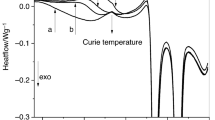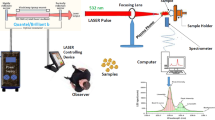Summary
The decomposition of forming, maturing, and mature enamel was studied between room temperature and 1,000°C by powder X-ray diffraction and infrared absorption methods. In mature dental enamel, carbonate decomposition proceeds relatively fast until 500°C and at a slower rate beyond it. In forming and maturing enamel, decomposition is faster and is completed around 800°C. The formation of β-Ca3(PO4)2 is observed in dental enamel at 500°C. At 1,000°C, the apatite phase in forming and maturing enamel transforms almost completely to β-Ca3(PO4)2, whereas in mature enamel, even at 1,000°C, only partial decomposition occurs. Infrared results show the appearance in dental enamel of (1) A-type carbonate at room temperature and in the 500–900°C range, in addition to the commonly observed B-type carbonate, and (2) intermediate CO2 molecules during carbonate decomposition (200–500°C).
Similar content being viewed by others
References
Le Geros RZ, Pentel L, Go P (1979) Thermal instability of human enamel and precipitated apatites. Caries Res 13:96
Balmain N, Legros R, Bonel G (1982) X-ray diffraction of calcined bone tissue: a reliable method for the determination of bone Ca/P molar ratio. Calcif Tissue Int 34:S93-S98
Young RA, Holcomb DW (1984) Role of acid phosphate in hydroxylapatite lattice expansion. Calcif Tissue Int 36:60–63
Baravelli S, Bigi A, Ripamonti A, Roveri N, Foresti E (1984) Thermal behavior of bone and synthetic hydroxyapatites submitted to magnesium interaction in aqueous medium. J Inorg Biochem 20:1–20
Perdok WG, Christoffersen J, Arends J (1987) The thermal lattice expansion of calcium hydroxyapatite. J Cryst Growth 80:149–154
Mortier A, Lemaitre J, Rouxhet P (1987) Formation of β-tricalcium di(orthophosphate) from mixtures of hydroxyapatite and calcium hydrogen orthophosphate. Thermochim Acta 113:133–139
Vignoles M, Bonel G, Young RA (1987) Occurrence of nitrogenous species in precipitated B-type carbonated hydroxyapatites. Calcif Tissue Int 40:64–70
Holcomb DW, Young RA (1980) Thermal decomposition of human tooth enamel. Calcif Tissue Int 31:189–201
Dowker SEP, Elliott JC (1983) Infrared study of trapped carbon dioxide in thermally treated apatites. J Solid State Chem 47:164–173
Deutsch D, Peer E (1982) Development of enamel in human fetal teeth. J Dent Res 61:1543–1551
Deutsch D, Shapira L, Alayoff A, Leviel D, Yoeli Z, Arad A, (1984) Protein and mineral changes during prenatal and postnatal development and mineralization of human deciduous enamel. In: Fernhead RW, Suga S (eds.) Tooth enamel IV. pp 234–239
Powder Diffraction File (1985) Edit. Int. Cent. Powder. Data, Swarthmore, Pa. Card No. 9-169
Featherstone JDB, Pearson S, Le Geros RZ (1984) An infrared method for quantification of carbonate in carbonated apatites. Caries Res 18:63–66
Schroeder LW, Dickens B, Brown WE (1977) Crystallographic studies of the role of Mg as a stabilizing impurity in β-Ca3(PO4)2. J Solid State Chem 22:253–262
Rey C, Collins B, Goehl T, Glimcher MJ (1988) Resolution-enhanced Fourier Transform Infrared study of phosphate environment in bone mineral. 3rd Conference of the Chemistry and Biology of Mineralized Tissue. Cape Cod, Mass, USA, October 1988, Abstracts p 148
Hallsworth AS, Robinson C, Weatherell JA (1972) Mineral and magnesium distribution within the approximal carious lesion of dental enamel. Caries Res 6:156–168
Bigi A, Foresti E, Incerti A, Roveri N, Borea PA, Zavagli G (1980) Chemical and structural study of the mineral phase associated with a human subcutaneous ectoptic calcification. Inorg Chim Acta 46:271–274
Deutsch D, Shapira L (1987) Changes in mineral distribution and concentration during enamel development in the deciduous human maxillary and mandibular teeth. Growth 51:334–341
Apfelbaum F, Mayer I, Featherstone JDB (in press) The role of HPO =4 and CO =3 ions in the transformation of synthetic apatites to β-Ca3(PO4)2. J Inorg Biochem
Author information
Authors and Affiliations
Rights and permissions
About this article
Cite this article
Mayer, I., Schneider, S., Sydney-Zax, M. et al. Thermal decomposition of developing enamel. Calcif Tissue Int 46, 254–257 (1990). https://doi.org/10.1007/BF02555004
Received:
Revised:
Issue Date:
DOI: https://doi.org/10.1007/BF02555004




